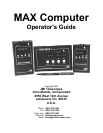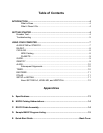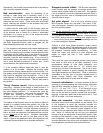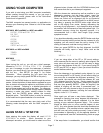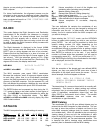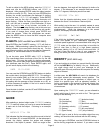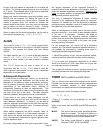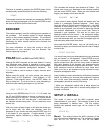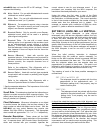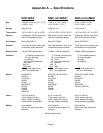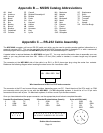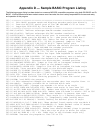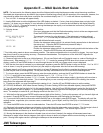
Page 6
Alternatively, the encoder can sometimes be re-mounted so
that it turns the opposite direction.
Bad encoder/cable. While the probability of an
encoder or cable being bad is extremely small, it is a
possibility. If the problem is isolated to either the cable or
encoder, there are a few simple tests which can quickly
determine the exact culprit. Follow each point as outlined
below, checking the operation of the encoders after each
until the problem disappears.
1. Confirm that all three ends of the encoder cable are
securely connected. If visible, inspect each of the four wires
at the encoder pins to check for a loose or intermittent
connection (it is normal for one of the second-to-outside
pins to have no connection).
2. Swap the two encoder ends of the encoder cable so that
the Right Ascension/Azimuth cable is plugged into the
Declination/Altitude encoder and vice-versa.
3. If the symptom is still present on the same displayed axis
after step 2, then the problem is in the encoder cable.
Remove the cable from the problem axis and check the wire
for damage and the cable's plug to see that all four golden
metal plates have been pressed down evenly. If necessary,
compare it with the other encoder plug. If one or more of
these plates is high, you may try to press it down carefully
with a small flat-head screwdriver or similar tool. If this
cannot be done, the cable should be replaced.
4. If the symptom switches axes after step 2, then the
problem is at the encoder. Remove the encoder cable
connector and visually inspect the jack on the encoder. The
four golden wires inside should be roughly even, although
they might be staggered high-low-high-low. If any of the
wires appears to be bent at an odd angle or pressed down
too much, this could be the problem. The jack may need to
be replaced.
"Hung" German mount. (German equatorial mount
users only). Because of the design of these mounts, it is
possible to point the telescope at the same location from
two quite different positions. To visualize this, point the
telescope at 0° Declination. Now rotate the telescope 180°
in each axis, avoiding the base as necessary. The
telescope is on the opposite side of the mount head, yet
pointing in the same direction.
This feature of the German mount is nice when an object is
located in a normally hard-to-view position, but it has the
added affect of changing the polarity of the Declination
encoder. For this reason, a unique stipulation is placed on
users of German mounts — when performing the encoder
test or an initial star alignment, the telescope tube must be
on the West
side of the mount. (Southern Hemisphere
users should place the tube on the East side of their
mount.) Refer to the addendum titled Star Alignments with
a German Equatorial Mount for a complete description.
Swapped encoder cables. The Encoder Installation
sheet included with the encoder mountings should detail
exactly which encoder cable is for each axis. As a general
rule, on equatorial mounts the Declination encoder cable is
the longer of the two, and on Altitude/Azimuth mounts the
Azimuth cable is longer.
Not polar aligned. This is not a true problem as the
MAX computer works very well even if the mount is 90°
from polar aligned. However, there are symptoms of which
the user should be aware.
First, do not use the EP or GP mount setting unless your
mount is accurately polar aligned, or you intend to use the
POLAR mode to assist in polar alignment. Please note that
the EP/GP settings assume a perfectly
polar aligned mount
— most pointing errors when using these settings are due
to an inaccurate polar alignment.
Second, a clock drive (Right Ascension motor) cannot
properly track the stars if the telescope mount is not polar
aligned — stars and other objects will appear to drift out of
the eyepiece, requiring regular re-positioning. In other
words, the closer your mount is to polar alignment the
longer an object will stay in view without manual
adjustments.
Third (and the cause of misplaced concern among some
new users of units such as the MAX computer), is the
simultaneous change of both Right Ascension and
Declination as seen under the
RA DEC display when
moving only one axis of the telescope. This is not an error
as the MAX computer is simply reporting the telescope's
true Right Ascension and Declination. What is commonly
overlooked is the fact that a non-polar aligned mount is
always moving through both Right Ascension and
Declination when either of its two axes is rotated.
Incorrect initialization. A common problem is that of
ignoring or misunderstanding the initial pointing instruction
from the MAX computer at power up (e.g.
SET DEC=0,
LEVEL ME, and VERTICAL). If you have set up the
MAX computer for a polar aligned telescope (EP or GP),
then you do not need to concern yourself with this aspect,
although it might be a good idea to be familiar with it. See
SETUP on page 11 for more information.
Slew rate exceeded. The MAX computer has a
maximum rate at which the encoders can be rotated. Due
to the frequency at which the computer samples the
encoders, they can be rotated faster than the computer can
accept the data. The maximum speed depends on the
number of tics per telescope axis rotation and the sampling
rate. While it is unlikely that you will spin your telescope
through a large arc fast enough to exceed this speed, it can
be jolted a small amount in a very short interval causing a
loss of alignment. With smaller telescopes and higher total
encoder resolutions you will be more susceptible, but under
normal operation you should never exceed the limit.



